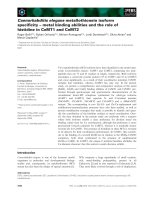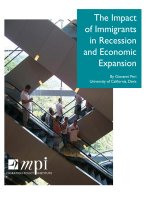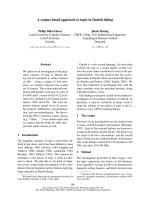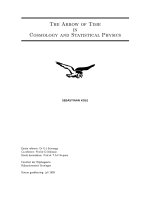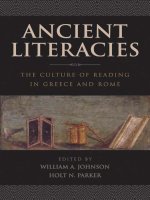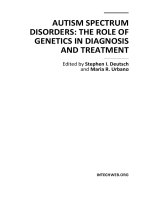The gulf of mexico oil spill a corpus based study of metaphors in british and american media discourse 3 1
Bạn đang xem bản rút gọn của tài liệu. Xem và tải ngay bản đầy đủ của tài liệu tại đây (1.49 MB, 49 trang )
69
CHAPTER 3
THE INTEGRATED APPROACH TO THE
IDENTIFICATION OF CONCEPTUAL METAPHORS
(IICM)
3.1. Introduction
This chapter aims to amalgamate existing theories and findings
pertaining to CMT from major contemporary perspectives into a suggested
unified framework for metaphorical analysis. This thesis proposes the
combination of two integrated online concordancing platforms to be utilised in
tandem with a structured methodological framework for the identification of
conceptual metaphors in media discourse. The two software platforms are
WMatrix (Rayson, 2008) and the Sketch Engine (Kilgarriff et al., 2004)
respectively. The strength of such an approach lies in two inter-connected
areas. Firstly, the inductive nature of this proposed conceptual metaphor
formulating process marks a departure from existing discourse-metaphor
studies. Secondly, this proposed method harbours the potential for an
exhaustive analysis of metaphors in a large swath of representative texts if
deemed necessary by the researcher.
It should also be made clear that the approach adopted in this chapter
to Conceptual Metaphor Analysis is a critical one - in the tradition of
Charteris-Black’s (2004) Critical Metaphor Analysis. This means that there
will be a significant emphasis on the socio-cultural, political and situational
context of the entire discourse in the resulting analysis. The interpretation of
70
this critical aspect will be facilitated by the adaptation of Grady, Taub &
Morgan’s (1996) metaphorical primitives and compounds. A detailed account
of the proposed metaphor identification procedures will be expounded in the
subsequent sections.
It is important to clarify that a definitive statement on a newspaper’s
stance cannot be made from a single study – due to the inherent limitations in
the scope and corpus. Thus, further research needs to be done in order to
extend these claims and to triangulate these findings over a range of issues for
statistical validity. However, for this thesis, all statements and claims are true
within the scope of these specific corpora.
3.2. An Overview: WMatrix (Rayson, 2005) & Sketch Engine
(Kilgarriff et al., 2004)
Now, I will proceed with a quick overview of the two proposed online
concordancing platforms. WMatrix (Rayson, 2005), a web-based interface for
corpus analysis with in-built semantic and lexical annotation capabilities, will
be used as a springboard for analysis. WMatrix also includes an in-built
selection of reference corpora obtained from sub-sections of the British
National Corpus (BNC) to provide standard frequency information with
reference to the corpus under analysis. Such a comparison can be done either
at a lexical or semantic level. The use of the semantic domains in WMatrix as
a springboard for subsequent metaphorical analysis ensures that the starting
point for the entire conceptual metaphor formulation process is empirically
based on Log-Likelihood values and is hence, both inductive and objective.
71
This is due to the fact that only the semantic domains and the corresponding
lexical items with a Log-Likelihood value of more than 6.63 corresponding to
99% significance will be chosen for metaphorical analysis.
At this juncture, it is important to note that Krennmayr (2011)
identifies two separate methodologies pertaining to the use of WMatrix as a
tool for metaphorical analysis. She divides these two methods neatly into a
“top-down” approach and a “bottom-up” approach. I would like to clarify that
there is a key difference for the terms of reference used in this paper. What
Krennmayr labels a “top-down approach” (p.194) is seen in this paper as a
“bottom-up approach”. Krennmayr labels her method as “top-down” as there
is the assumption that a conceptual mapping pre-exists within selected
semantic fields before linguistic evidence for metaphoricity is sought. While
Krennmayr has a valid point, this approach can also be seen as an inductive,
“bottom-up” approach. This is because the USAS domains merely provide an
indication of the semantic categories that stand out from the reference text.
The conceptual metaphors will only be formulated from a detailed analysis of
the relevant lexical units and their respective concordances. This point is best
captured by Deignan (1999) who states that “there is no automatic way of
discovering the linguistic realisations of any conceptual metaphor, because a
computer cannot tell the researcher anything about speaker meaning.
Concordances will show the researcher words in their context, but he or she
has to process this information” (p.180). Thus, it is undeniable that the need
for informed researcher intuition remains necessary for metaphor analysis.
However, the USAS domains serve as an empirical springboard for further
analysis in an inductive approach that does not depend on pre-determined
72
search strings. It is important to note that this treatment of the WMatrix USAS
semantic domains for metaphorical analysis is unique and differs from Hardie
et al.’s (2007) approach. This novel treatment is predicated on the aim of this
thesis to devise a point of entry to the analysis of data in a large swath of texts
that is empirical and inductive. It is important to note that the need for
researcher intuition is not being discounted. It is undeniable that informed
researcher intuition is an integral part of all discourse-analytical corpus
research past and present – and the entire range of early metaphor studies that
use the intensive manual analysis of representative data have resulted in
significant strides forward in the field of metaphor studies. However, the main
aim of this thesis lies in the formulation of a proposed method that exploits the
major computational advancements in existing concordancing software and
strikes an adequate balance between semi-automated and manual analysis.
Secondly, the use of “word sketches” in Sketch Engine (Kilgarriff et
al., 2004) adds another dimension of refinement. This is because the actual
formulation of the conceptual metaphors from linguistic evidence will be
based on the node word’s grammatical and collocational behaviour. This
simply means that the concordances examined will be further parsed according
to the grammatical relation of the node word, resulting in a more refined
approach to the formulation of conceptual metaphors from linguistic evidence.
Hence, the additional part-of-speech annotation afforded by word sketch
refines the metaphorical analysis because “collocates may differ considerably
between nouns and verbs of the same lemma” (Oster, 2010, p.735). This is a
significant departure from the previous practice of merely examining the
“arbitrary window of text around the headword” for the first pre-designated
73
number of lines (p.3). Thus, the additional implementation of the word sketch
function in Sketch Engine adds on to the arsenal of “corpus interrogation
strategies” by further refining the generated concordances in accordance to the
node word’s grammatical category (Kilgarriff et al., 2004, p.3). This provides
an added dimension of systematicity to the metaphorical analysis of the
concordances.
It is important to note that both WMatrix and Sketch Engine advocate a
lexical approach as the springboard for the analysis for conceptual metaphors.
This method is justified by Kovecses (1990, 2008) who states that “language
and its lexicon is a reflection of our conceptual system” (p.41). Thus, the
analysis and formulation of the associated conceptual metaphors in this thesis
is based on the collective amalgamation of linguistic expressions such as
“metaphors, metonymies, idioms, proverbs and collocations” (p.43). This
forms the backdrop for this bottom-up corpus-based study of conceptual
metaphors from empirical linguistic evidence. The key departure from
Kovecses’ method is that the data used for analysis in this research is based on
corpus data or found data rather than elicited data.
Oster (2010) also justifies the use of the lexical unit as a springboard
for the analysis in a large representative corpus. He states that by exploring the
span of the node word, we are able to “find evidence of conceptual metaphor
and metonymy that structure the (target) concept” and “enrich” the description
of the concept with information with a “pragmatic viewpoint from a series of
dimensions” (p.727). This justifies the corpus approach and the use of
semantic domains, the lexical unit and the accompanying co-texts as a
springboard for analysis.
74
Hence, it is proposed that this framework for metaphorical analysis
based on integrated online concordancing platforms like WMatrix (and its
corresponding USAS and “broad-sweep” functions) and Sketch Engine (and
the resulting word sketches) reduces the reliance on researcher intuition as the
starting point of corpus research and results in findings that are inductive,
potentially comprehensive, empirically-based and repeatable. Furthermore,
with subsequent iterations, it can potentially serve as an alternative inductive
framework that triangulates the findings of the corresponding deductive
methodologies based on intensive manual analysis of representative corpora,
providing an element of robustness that complements the integral function of
informed researcher intuition.
3.3. Theoretical Framework: A Unified Analysis of Conceptual
Metaphors
It is undeniable that the news is both, a primary determinant and an
indicator of public perceptions. This is because of its reach and the fact that it
provides the masses with information within an “authoritative” framework for
interpretation and/or disagreement. While it is over-simplistic to attribute the
news with the power to straitjacket the masses’ perceptions, particular aspects
of reality can become impossible to challenge when they become shared
beliefs or represent “commonsense” through strategic media representations.
Graber, McQuail & Norris (2008) claim that the demand for information
becomes heightened especially in situations of international conflict and
political crisis. This climate of unrest has become pre-eminent since the 9-11
75
attacks in 2001, exacerbated by the current climate of political uncertainty and
economic malaise in the US and in the Euro-zone. Apart from adapting to this
climate of unrest, the news also needs to acclimatise to the highly fragmented,
quasi-regulated nature of social media which has intensified media
competition and “destabilised established media structures and relationships”
(p.273).
In the case of the Gulf of Mexico oil spill, the inextricable nature of the
relationship among journalism, politics, society and the inelastic nature of the
embedded socio-historical and cultural factors necessitate a critical tradition in
the analysis of metaphors. Hence, critical metaphor analysis plays a major role
in uncovering the underlying competing ideologies between the stakeholders.
This is especially intriguing as this crisis has dimensions of an international
conflict between America and Britain (as BP has distinctly British origins),
and thus, nationalistic sentiments will undoubtedly be brought to the forefront
on both sides. On the other hand, this crisis also contains elements of a
national domestic crisis in terms of the resulting environmental destruction
and the widespread public discontent arising from the lack of an enforcement
body that protects and regulates national interests. Hence, this interaction
between the global and the national fronts is of significant interest as we enter
the post-9-11 timeframe, widely recognised as a period of international unrest
and increased military intervention by the state due to the “newly perceived
threats to the established international order and its value system” (p.270).
However, before a validated metaphor analysis of the target discourse can take
place, there is an urgent need to ensure a well-structured and comprehensively
documented metaphor identification and formulation procedure that is
76
theoretically sound and repeatable. The key concern is thus to formulate
coherent methodological criteria that are well delineated at every step such
that the formulation of conceptual metaphors from linguistic evidence can be
repeatable and exhaustive (Oster, 2010, p.731). The next segments will
expound on the three major theoretical underpinnings underlying the proposed
Integrated-approach to the Identification of Conceptual Metaphors
(henceforth IICM):
1. Extracting metaphors from corpora by searching for target domain
vocabulary (Stefanowitsch, 2006) (Section 3.3.1)
2. An adaptation of Grady, Taub & Morgan’s (1996) Metaphorical
Primitives and Compounds (Section 3.3.2)
3. The Major Metaphorical Categories used in this analysis (Lakoff &
Johnson, 1980; Lakoff, 1992; Gibbs, 1999; Kovecses, 2002) (Section
3.3.3)
3.3.1. Extracting metaphors from corpora by searching for target
domain vocabulary (Stefanowitsch, 2006)
In Stefanowitsch’s (2006) insightful overview of the methodological
problems and possible solutions to corpus-based research in the field of
metaphor, he expounds on the methodological possibility of searching for
conceptual mappings by identifying the relevant target domains (p.3). The key
pre-requisite for this endeavour would be the existence of a large,
representative and “monothematic” corpus dealing with target domains (e.g.
77
ECONOMICS, SPORTS, POLITICS). In this thesis, the corpus essentially focuses
on the target domains comprising the BP Oil Spill and the relevant entities
encapsulated within the narrative (such as BP itself, the British and American
Governments, the spilt oil as an entity, the notions of POLITICS and
INTERNATIONAL RELATIONS in general etc.). The next step would involve
identifying the conceptual metaphors occurring within the vicinity of the
selected node word that embodies the target domain. It is important to note
that Stefanowitsch expresses two main reservations with this methodology –
due mainly in part to the technological limitations at the time of writing (p.3-
4):
1. It will “only identify a subset of metaphorical expressions (that)
contain target domain vocabulary”.
2. It will not identify metaphorical expressions “exhaustively or
systematically” as it will only identify the source domains that are
associated with statistically-salient lexical items within the corpus.
However, both these concerns are alleviated to a certain extent with the
recent developments in concordancing technology. As WMatrix provides
comprehensive lexical and semantic corpus annotation, exhaustive lists of
semantic domains and lexical items are fully available for the metaphor
analyst. This simply means that the metaphor analyst is free to systematically
analyse the complete range of semantic domains for metaphoricity if the
need arises. Thus, the efficient annotation of large corpora has enabled the
complete and practical realisation of Stefanowitsch’s proposed methodology.
78
However, the key shortcoming that remains with this approach would be the
need for manual post-editing of the corpora due to a number of “false hits”.
This is the result of the shortcomings with the semantic tagger where its
accuracy remains in doubt - especially with respect to new lexical additions
and culture-specific semantic shifts to the lexicon. At this juncture, it is
important to note that the specific exploitation of WMatrix for metaphorical
analysis within this thesis is unique and is a departure from existing
methodologies in the tradition of Hardie et al. (2007) and Koller et al. (2008).
Thus, the framework for formulating conceptual metaphors advocated in this
thesis is an inductive approach that uses empirically-based linguistic evidence
generated from concordances to formulate the “reconstructed conceptual
structures” in a systematic manner that can be potentially exhaustive (Steen et
al., 2010, p.760).
3.3.2. Metaphorical Primitives & Compounds (Grady, Taub & Morgan,
1996)
There is an urgent need to formulate a systematic model that
streamlines the sprawling metaphorical complexes that often arise from large-
scale discourse studies. This is simply due to the resultant range of metaphors
that seem to lack a coherent hierarchical structure. Hence, an adaptation of
Grady, Taub & Morgan’s (1996) proposed diagrammatic representations of
metaphors will enable the analyst to have a pictorial grasp of the overarching
entailments and the range of conceptual metaphors employed in the analysis of
the discourse. The diagrammatic representation of these metaphorical
79
complexes would facilitate the critical study of metaphors by identifying the
metaphorical compounds and the range of associated metaphorical primitives.
Grady, Taub & Morgan (1996) claim that metaphors are either primitives or
are composed of primitives. This means that virtually every complex metaphor
is a “metaphoric compound” that is compositional in nature. Here are the two
key terms involved in this delineation (p.181):
1. A metaphoric primitive consists of a single metaphorical mapping
which exists independently of any particular complex metaphorical
structures. They tend to have “an independent and direct experiential
basis and independent linguistic evidence”.
2. A metaphoric compound is a “self-consistent metaphorical complex”
composed of two primitives or more.
A pictorial representation of this idea is captured by Grady, Taub & Morgan in
Fig 3.1.
Fig. 3.1.
Pictorial Representation of Metaphorical Primitives and Compounds – “MORALITY IS A
STRAIGHT PATH / MORALITY IS TAKING THE HIGH GROUND” (Grady, Taub & Morgan, 1996, p.183)
MORAL ACTION IS STRAIGHT MOTION / MORAL ACTION IS MOTION ALONG AN
ELEVATED PATH
There are three main benefits of adopting this simple yet powerful delineation.
CANONICAL
IS STRAIGHT
ACTION IS
MOTION
MORAL IS UP
80
• Firstly, this classification essentially refines CMT by resulting in the
efficiency of analysis. This simply means that the current sprawling
metaphorical complexes can be adequately represented in an effective
diagram, organising the range of conceptual metaphors into a coherent
hierarchical framework. The hierarchical aspect of the representation in
terms of frequency is reflected by the corresponding size of the circles
– the more statistically significant the metaphor type, the bigger the
circle. This is significant as efficiency should be the “default goal for
any formal analysis” (p.185).
• Secondly, the delineation of metaphors into primitives and compounds
also enables the cross-cultural comparisons of complex metaphors.
This is due to the fact that a direct inter-textual comparison of the
metaphorical primitives (which tend to be more experientially
embodied) enables the analyst to see the direct contextual and cultural
influences. This is because metaphorical primitives offer an important
set of “general constraints” on people’s thinking that are bound by
context and culture (Johansson Falck & Gibbs Jr, 2012, p.254). Hence,
including Grady, Taub & Morgan’s classification in the present study
can facilitate cross-cultural critical comparisons of metaphors across a
representative set of British and American media texts through an in-
depth pictorial overview of the associated conceptual metaphors.
• Thirdly, this neat delineation is cognitively efficient as it accounts for
the phenomenon where conceptual mappings usually turn out to be
amalgamations of multiple overlapping partial mappings due to the
81
invariance principle. The invariance principle states that only those
portions of the source that do not “conflict with the schematic structure
of the target can be mapped” (Kovecses, 2002, p.94). Hence,
metaphorical mappings from a source to a target are only partial as
each source can only structure certain aspects of a target for analogy
formation, metaphorical referencing and conceptual blending. As a
result, these diagrammatic depictions adequately capture the eclectic
combination of the conventional, the contextual and the innovative.
Thus, the adaptation of Grady, Taub and Morgan’s representation of
conceptual metaphors provides for a more complete representation of
the resultant interactions between the conceptual metaphors in the
target discourse.
3.3.3 Key Metaphorical Classifications (Lakoff & Johnson, 1980;
Lakoff, 1992; Gibbs, 1999; Kovecses, 2002)
The metaphor representations mined inductively from the online
concordancing platforms will then be classified diagrammatically into four
separate metaphor categories. This will be done in accordance to a
classification that amalgamates Lakoff and Johnson (1980), Lakoff (1992),
Gibbs (1999) and Kovecses’ (2002) classifications of metaphor categories.
Here are the four proposed categories:
1. Structural Metaphors (A IS B/ A IS LIKE B): Refers to the typical
cross-domain metaphors and similes in the traditional form of
82
conceptual metaphor where an abstract concept is understood by the
structure of the source concept (Lakoff & Johnson, 1980, p.3;
Koveces, 2002, p.37).
2. Ontological Metaphors (e.g. Container Metaphors/
Personification): Provides much less cognitive structuring for
concepts than structural metaphors but it assigns a tactile link to
objects and substances for conceptual concretization. (Lakoff &
Johnson, 1980, p.25; Kovecses, 2002, p.38).
3. Orientational/Spatial Metaphors (e.g. MORE IS UP/LESS IS
DOWN, HEALTHY IS UP/SICK IS DOWN): Provides even less
conceptual structure than Ontological metaphors but they serve the
vital function of enhancing the coherence of target concepts via
physical/spatial orientation (Lakoff & Johnson, 1980, p.14;
Kovecses, 2002, p.40).
4. Image Metaphors/Analogy-based Metaphors (e.g. “My wife
whose hair is brush fire, whose waist is an hourglass”, “American
civilisation is like an orchestra (the symphony of civilisation)”):
Used in contexts where mental images from one source of
knowledge are mapped onto another in a “one-shot metaphor”
(rather than inter-domain concept mapping). In particular, this
describes situations where aspects of the part-whole structure of one
image is mapped onto aspects of the part-whole structure of another,
limited only by the Invariance Principle. It is important to note the
potential overlaps with Ontological Metaphors (Lakoff, 1992;
Gibbs, 1999, p.32).
83
Thus, this proposed framework for the classification of conceptual
metaphors from linguistic evidence is clear. By incorporating WMatrix and
Sketch Engine as empirical springboards for metaphor analysis, the resultant
system of conceptual metaphor identification has the potential to be more
systematic, empirical and exhaustive, minimising the possibility of the
researcher overlooking potentially salient alternative mappings and
inadvertently compromising on the potential metaphorical richness of the data.
3.4. The Integrated-Approach to the Identification of Conceptual
Metaphors (IICM)
The following segments will demonstrate and explicate the use of the
proposed IICM for an in-depth metaphorical analysis of the BP oil spill in
British and American newspapers. This will be accomplished through the use
of WMatrix and Sketch Engine as springboards for metaphorical analysis.
The new proposed framework comprises an amalgamation of the three
theoretical underpinnings discussed earlier in this chapter.
1. A unique approach to the exploitation of WMatrix based on
Stefanowitsch’s (2006) proposed methodology of extracting metaphors
from corpora by searching for target domain vocabulary.
2. The classification of these inductively mined metaphors into four
categories based on existing classifications by respected metaphor
theorists (section 3.3.3).
84
3. An adaptation of Grady, Taub & Morgan’s (1996) pictorial
representation of metaphorical primitives and compounds in a
diagrammatic arrangement (section 3.3.2).
3.4.1. An overview of the IICM Framework
Here are the steps for the proposed Integrated-Approach to the
Identification of Conceptual Metaphors (IICM). It is broadly divided into
three separate Phases.
Phase One: After running the corpus through WMatrix, identify candidate
USAS semantic categories for analysis based on frequency.
• The informative writing section of the BNC sampler will be used as a
reference corpus. Only the top-30 semantic domains that are overused,
i.e. with a log likelihood threshold of at least 6.63 (corresponding to
99% significance or 1 degree of freedom) or above will be selected for
this preliminary analysis
1
. This step is followed by the identification of
a statistically-salient metaphor related node-word on a linguistic level
within the target USAS semantic domain in WMatrix (e.g. a target
domain like “oil”).
• Upon the selection of the Semantic Domain, the “broad-sweep”
function in WMatrix will be executed. As mentioned earlier (in Section
2.2.10), the “broad-sweep” function ensures that the search includes all
1
This does not preclude an exhaustive analysis – as the analyst is free to analyse every
semantic domain and lexical item generated by WMatrix.
85
lexical items with a relevant tag in their list of tags. Thus, this provides
a platform for a thorough metaphorical analysis that is inductive and
comprehensive – limited only by the shortcomings of the in-built
semantic tagger. However, this can be easily rectified with some
manual reconfiguration of the lexicon within the target corpus.
• The node word for analysis should be empirically selected from this
broad-list based on its frequency of overuse/salience as determined by
the raw and relative frequency counts accompanying each lexical item.
This process is facilitated by the fact that the lexical items within each
semantic domain is presented in descending order of frequency, with
the most frequent occurrences on the top of the list. Hence, the final
selection of USAS semantic domains and the associated lexical items
for analysis should be influenced by empirical suggestion (embodied
by a log likelihood value of >6.63 for one degree of freedom or by the
accompanying frequency indicators) and by the specific demands of
the discourse in context. This is a significant departure from the usual
practice of using “pre-determined search strings” as a point of entry for
metaphorical analysis. This proposed utilisation of the USAS semantic
domains thus systematises the pre-selection of the data for
metaphorical analysis.
Phase Two: Formulating the associated Conceptual Metaphors using a
proposed four-step approach
• Step One – Identifying the Collocations & Lexical Items for
86
Metaphorical Analysis (via Sketch Engine). This entire process is
facilitated by the “word-sketch” function in Sketch Engine. A word
sketch is essentially a “corpus-based summary of the grammatical and
collocational behaviour of a node word” (Kilgarriff et al., 2004, p.1).
It provides an added modicum of refinement to the metaphor
formulation process by dividing the node word analysis into separate
grammatical categories. This is a distinct improvement from the usual
analysis of an “arbitrary window of text around the head-word” (p.3).
The word sketch function hence facilitates the exhaustive
identification of clauses and the accompanying verbs, adjectives and
nouns within a fixed span of the node word. A “sentential” span of
one sentence preceding and one sentence after the node word will
be used in order to ensure internal consistency throughout this
analysis.
• Step Two – The identification of Conceptual Keys/Scenarios
(Charteris-Black, 2004; Musolff, 2004) from the accompanying
verbs, adjectives and nouns within a fixed sentential span of the
node word through the use of an ordered table. These identified
words within the designated span of one sentence before and after the
node word will be organised through the use of a table. It is important
to note that while the MIP (Pragglejaz Group, 2007) makes decisions
on linguistic metaphoricity at the level of individual words, this thesis
chooses to analyse the relevant clauses as a whole, focusing on the
cognitive structuring provided by the conceptual metaphors and their
resultant entailments rather than on the derivation of the linguistic
87
metaphors per se. This is based partially on Oster’s (2010)
“qualitative context-based filtering”, which is essentially an
adaptation of the MIP as the analysis in this thesis deals with a “list of
co-occurrences” rather than “linear textual analysis” (p.738). This
simply means that the co-text is scanned for potential metaphoricity
before the contexts are retrieved and expanded for further analysis.
The significant collocations of the node words are then identified by
virtue of their salience in terms of frequency. The dictionary
definition of these significant collocations are then sought to
determine its contextual meaning. This is done in order to identify the
relevant Conceptual Keys and Scenarios that structure the associated
Conceptual Metaphors. Just like the MIP (Pragglejaz Group, 2007),
this thesis utilises the Macmillan Online Dictionary and the Collins
Online Dictionary, corpus dictionaries based on a systematically
processed corpus of 220 million words of contemporary English,
which is important for the formulation of metaphors in contemporary
news texts. The use of corpus-based dictionaries systematises the
formulation of conceptual metaphors by counter-balancing the
analysts’ intuitions with actual linguistic evidence.
However, for the IICM, it is important to identify the relevant socio-
political/situational contexts in the target discourse and the co-texts
that can be linked to a conceptual shift rather than on the
metaphoricity of the individual words in the sentence per se. This is
in accordance to Sinclair’s (2004) postulation that the lexical unit is
merely the pre-determined centre of a longer sequence of co-
88
occurring words. The importance of examining the co-text is best
captured by Hunston’s (2007) study of the phenomenon of semantic
prosody where the “attitudinal context of a lexical item may be
contingent upon other aspects of items in the immediate co-text”
(p.253). Hence, this underscores the importance of examining the
immediate co-text in determining the underlying attitudinal discourse
function of the unit of meaning under analysis.
• Step Three – The identification of the range of conceptual
metaphors through the macro-reclassification, comparison and
analogical structures of the available socio-political and
situational contextual details linked to the node word. This means
that the source and target domains associated with each node word
are determined by analysing and grouping the words within its
designated sentential span. Once again, the significant collocations of
the node words are then identified by virtue of their salience in terms
of frequency and the dictionary definition is then sought to determine
its contextual meaning as the basis for conceptual metaphor
formulation. This adds an element of systematicity to the formulation
of conceptual metaphors as it is based on the definitions of the
Macmillan Online Dictionary and the Collins Online Dictionary, two
contemporary corpus dictionaries. The use of reliable corpus
dictionaries substantiates the scope for the identified metaphorical
lexical unit, making it “possible to characterise the mappings with
greater precision than typically done in linguistic research which rely
solely on an individual analyst’s intuitions with no supporting
89
criteria” (Pragglejaz Group, 2007, p.35). Further detailed analysis of
the selected node word can be done via an expansion of the co-text
surrounding the node word. This function of complete co-text
expansion is provided by both the WMatrix and Sketch Engine
platforms. It is important to note that this methodology focuses on the
cognitive structuring of the metaphorical manifestations from the
salient broad source and target domains and their relevant extensions.
This simply means that the focus is placed on the cognitive function
of metaphors, with the general understanding that many instances of
the linguistic manifestations of metaphor and its accompanying
cognitive dimensions often overlap and co-occur.
• Step Four - The formal representation of the identified complex
of metaphors through the adaptation of Grady, Taub & Morgan’s
(1996) concept of Metaphorical Primitives and Compounds. This
is significant as the adaptation of Grady, Taub & Morgan’s (1996)
concept of Primitive and Complex metaphors provides a systematic
account of the various metaphorical complexes in the target
discourse. In other words, it is a systematic and integrated visual
representation of Musolff’s (2004a, 2004b) Scenarios/Conceptual
Metaphors and Charteris-Black’s (2004) Conceptual Keys/
Conceptual Metaphors/Linguistic Metaphors. The hierarchical aspect
of the representation is captured by the corresponding size of the
circles that reflects the frequency of occurrence of the selected
metaphor type. The delineation between metaphorical primitives and
compounds provides an additional contextual and experiential basis
90
for the analysis. This is because the embodied nature of metaphor
results in participants negotiating the way a concept is represented
and understood in specific situations. This facilitates a textured cross-
cultural metaphor analysis.
Phase Three: Generalizing the findings in order to suggest understanding or
thought patterns that construct or constrain people’s beliefs and actions
through Critical Metaphor Analysis (Charteris-Black, 2004). This process is
facilitated by the diagrammatic representations in Step Four where the
hierarchical representations and the socio-political/historical contexts are
taken into account. This final step completes the entire metaphor formulation
and analysis loop, propagating a metaphor identification and analysis
procedures that is based on empirical and inductive principles in a critical
tradition.
Thus, this framework aims to use a combination of automatic semantic
analysis, key word identification and domain techniques in order to develop a
new methodology for the computer-assisted analysis of metaphorical patterns
in discourse for large collections of texts that is both inductive and empirical
in its pre-selection of data for metaphorical analysis. In other words, this
proposed framework can potentially be used to triangulate the findings of
traditional intensive manual analysis of representative data through the use of
a framework that minimises the use of “pre-determined search strings”. In the
process, this proposed framework also minimises the chances of missing out
on large chunks of relevant and possibly significant lexical items as the
researcher can theoretically adopt an exhaustive approach to the analysis of
91
the semantic domains and the lexical items comprehensively generated by
WMatrix and Sketch Engine. Furthermore, the selection of lexical items for
analysis in this framework is based on the empirical suggestion of candidate
semantic fields proposed by USAS, a semantic annotation tool embedded
within the WMatrix web-based concordancing programme. As a result, this
method of analysis is potentially a lot more inductive, has the potential to
generate comprehensive results and most importantly, is repeatable and
empirical. Furthermore, as mentioned earlier, this methodology has the added
advantage of potentially being used to triangulate the findings of traditional
intensive manual analysis of representative data in order to augment the
robustness of the associated study.
3.5. The IICM in action
3.5.1. Preliminary Procedures
The next few segments will demonstrate the use of the IICM
framework for metaphorical analysis. Utilising the USAS semantic domains
within WMatrix as the starting point of the analysis, an analysis of the
semantic tagset was carried out, with the initial focus being the frequency
counts of the statistically salient semantic domains. A keyness analysis was
also run on the corpus with respect to the 745, 726 word BNC Sampler written
informative corpus (Fig. 3.2). The analysis was based on the lexical choices
found within the top-30 semantic domains of interest. These semantic domains
have log-likelihood values way above the critical value of 6.63, or the 99
th
92
percentile for one degree of freedom for the comparison of two sets of
corpora. While the steps outlined here are for the purposes of a preliminary
analysis, the key advantage of using WMatrix as a springboard for a
discourse-analytic metaphorical study is that an exhaustive analysis can be
carried out for all the lexical items generated by the platform if deemed
suitable by the researcher.
Fig. 3.2.
Screenshot of reference corpora for analysis: BNC Sampler Written: Inform
]
Fig. 3.3 shows a partial screenshot of the top-30 semantic domains pertaining
to the BP Oil Spill for the New York Times Corpus (henceforth NYT-Corpus).
Fig.3.3.
USAS Semantic Tagset for NYT-Corpus (Top-30 semantic domains)
These semantic domains will be the springboards from which the relevant
conceptual metaphors will be identified. As an example, ‘Substances and
Materials: Liquid’, the first USAS domain on the list will be chosen for
93
analysis due to its empirical salience as well as its potential to function as a
target domain in the context of this discourse. Note that in Fig. 3.4, 3.5 and
3.6, there are three separate wordlists that can be generated for further
analysis. Here is an explanation of the three separate wordlists and their
corresponding functions.
‘List1’ shows the words which have been assigned to a given semantic
category (Fig.3.4). It is important to note that the generated list is in
descending order of frequency – with the most empirically salient lexical item
foregrounded on top of the list.
Fig.3.4.
List1 – ‘Substances and materials: Liquid’ (NYT_1) – top 12 items
‘Broad-list’ shows the words which could have been assigned to a given
semantic category - i.e. those in ‘List1’ plus those that contain that category in
their entry in the semantic lexicon (Fig. 3.5.). As with List1, the Broad-list is
also arranged in descending order of frequency with the statistically salient
lexical items placed on top of the list. This is key as an empirical basis for the
selection of lexical items for further study is vital for an inductive approach to
the metaphorical analysis of a large corpus.
Fig. 3.5.
Broad-list – ‘Substances and materials: Liquid’ (NYT_1)- top-12 items


